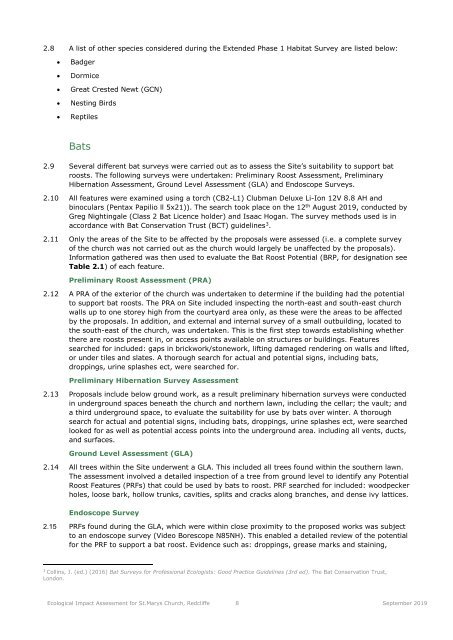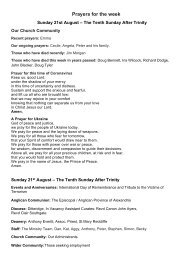St Mary Redcliffe Ecological Impact Assessment
You also want an ePaper? Increase the reach of your titles
YUMPU automatically turns print PDFs into web optimized ePapers that Google loves.
2.8 A list of other species considered during the Extended Phase 1 Habitat Survey are listed below:<br />
• Badger<br />
• Dormice<br />
• Great Crested Newt (GCN)<br />
• Nesting Birds<br />
• Reptiles<br />
Bats<br />
2.9 Several different bat surveys were carried out as to assess the Site’s suitability to support bat<br />
roosts. The following surveys were undertaken: Preliminary Roost <strong>Assessment</strong>, Preliminary<br />
Hibernation <strong>Assessment</strong>, Ground Level <strong>Assessment</strong> (GLA) and Endoscope Surveys.<br />
2.10 All features were examined using a torch (CB2-L1) Clubman Deluxe Li-Ion 12V 8.8 AH and<br />
binoculars (Pentax Papilio ll 5x21)). The search took place on the 12 th August 2019, conducted by<br />
Greg Nightingale (Class 2 Bat Licence holder) and Isaac Hogan. The survey methods used is in<br />
accordance with Bat Conservation Trust (BCT) guidelines 3 .<br />
2.11 Only the areas of the Site to be affected by the proposals were assessed (i.e. a complete survey<br />
of the church was not carried out as the church would largely be unaffected by the proposals).<br />
Information gathered was then used to evaluate the Bat Roost Potential (BRP, for designation see<br />
Table 2.1) of each feature.<br />
Preliminary Roost <strong>Assessment</strong> (PRA)<br />
2.12 A PRA of the exterior of the church was undertaken to determine if the building had the potential<br />
to support bat roosts. The PRA on Site included inspecting the north-east and south-east church<br />
walls up to one storey high from the courtyard area only, as these were the areas to be affected<br />
by the proposals. In addition, and external and internal survey of a small outbuilding, located to<br />
the south-east of the church, was undertaken. This is the first step towards establishing whether<br />
there are roosts present in, or access points available on structures or buildings. Features<br />
searched for included: gaps in brickwork/stonework, lifting damaged rendering on walls and lifted,<br />
or under tiles and slates. A thorough search for actual and potential signs, including bats,<br />
droppings, urine splashes ect, were searched for.<br />
Preliminary Hibernation Survey <strong>Assessment</strong><br />
2.13 Proposals include below ground work, as a result preliminary hibernation surveys were conducted<br />
in underground spaces beneath the church and northern lawn, including the cellar; the vault; and<br />
a third underground space, to evaluate the suitability for use by bats over winter. A thorough<br />
search for actual and potential signs, including bats, droppings, urine splashes ect, were searched<br />
looked for as well as potential access points into the underground area. including all vents, ducts,<br />
and surfaces.<br />
Ground Level <strong>Assessment</strong> (GLA)<br />
2.14 All trees within the Site underwent a GLA. This included all trees found within the southern lawn.<br />
The assessment involved a detailed inspection of a tree from ground level to identify any Potential<br />
Roost Features (PRFs) that could be used by bats to roost. PRF searched for included: woodpecker<br />
holes, loose bark, hollow trunks, cavities, splits and cracks along branches, and dense ivy lattices.<br />
Endoscope Survey<br />
2.15 PRFs found during the GLA, which were within close proximity to the proposed works was subject<br />
to an endoscope survey (Video Borescope N85NH). This enabled a detailed review of the potential<br />
for the PRF to support a bat roost. Evidence such as: droppings, grease marks and staining,<br />
3 Collins, J. (ed.) (2016) Bat Surveys for Professional Ecologists: Good Practice Guidelines (3rd ed). The Bat Conservation Trust,<br />
London.<br />
<strong>Ecological</strong> <strong>Impact</strong> <strong>Assessment</strong> for <strong>St</strong>.<strong>Mary</strong>s Church, <strong>Redcliffe</strong> 8 September 2019


















